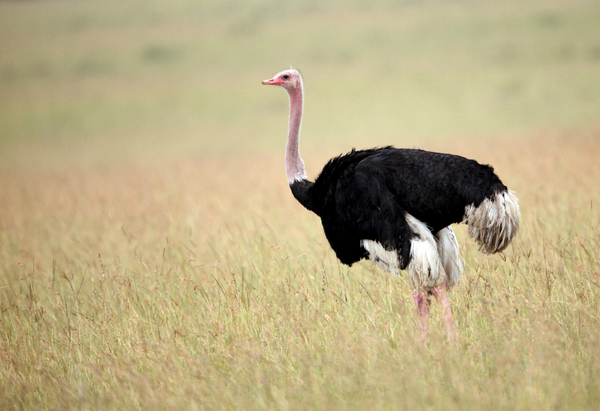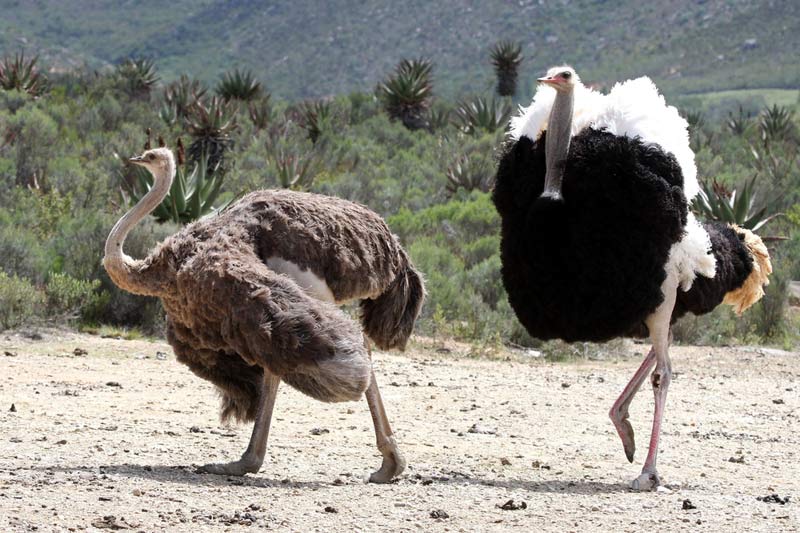Ostrich facts: The world's largest bird
Ostriches have the largest eye of any land vertebrate.

Ostriches are large, flightless birds that have long legs and a long neck that protrudes from a round body. Males have bold black-and-white coloring that they use to attract females. Females, on the other hand, are light brown.
Ostriches are bigger than any other bird in the world. They can grow up to 9 feet (2.7 meters) tall and can weigh up to 320 pounds (145 kilograms), according to the African Wildlife Foundation, and an ostrich's eyes are 2 inches (5 centimeters) in diameter — the largest of any land animal. The ostrich is the only bird that has two toes on each foot. All other birds have three or four toes, according to the American Ostrich Association.
Where do ostriches live?
Wild ostriches live in the dry, hot savannas and woodlands of Africa. They once roamed all over Asia, Africa and the Arabian Peninsula, but because they have been hunted so extensively, wild ostriches' range has been reduced to sub-Saharan Africa, according to the University of Michigan Museum of Zoology. However, ostriches can be found in captivity all over the world.
What do ostriches eat?
Ostriches are omnivores, which means they eat both vegetation and meat. Although they prefer plants — especially roots, seeds and leaves — they also eat locusts, lizards, snakes and rodents, according to the San Diego Zoo. They also eat sand and pebbles, to help grind up their food inside their gizzard, which is a small pouch where food is crushed and ripped up before it reaches the stomach.
Ostriches don't need to drink water; they get all the water they need from the plants they eat. However, they do drink if they come across a watering hole.
Mating habits
Male ostriches are called cocks or roosters, and females are called hens. A group of ostriches is called a flock. Flocks can consist of up to 100 birds, though most have 10 members, according to the San Diego Zoo. The group has a dominant male and a dominant female and several other females. Lone males come and go during mating season.
To get a female's attention, males bow and flap their wings outward to display their plumage. When they are ready to mate, the male's beak and shins will turn bright red. Sometimes, his neck will change to a red color to match. Females also change color when they are ready to mate. Their feathers will turn a silvery color, according to the American Ostrich Association.
Get the world’s most fascinating discoveries delivered straight to your inbox.
Ostrich eggs & baby ostriches
Ostrich eggs are 6 inches (15 cm) in diameter and can weigh up to 3 pounds (1.3 kg). Eggs are laid in a communal nest called a dump nest, which can hold about 60 eggs at one time. Males, as well as females, sit on the eggs until they hatch, which can take 42 to 46 days.
Ostrich offspring are larger than any other bird baby. At birth, chicks can be as big as chickens. The males and females share the responsibility of taking care of the young, according to the San Diego Zoo. During an attack, the male tries to lure the predator away from the chicks while they run for cover with the female.
By six months, a chick is almost at its full-grown height; at 3 or 4 years, it will reach maturity. An ostrich can live 50 to 75 years.
Classification/Taxonomy
According to the Integrated Taxonomic Information System (ITIS), the taxonomy of the ostrich is as follows:
- Kingdom: Animalia
- Phylum: Chordata
- Class: Aves
- Order: Struthioniformes
- Family: Struthionidae
- Genus & species: Struthio camelus
- Subspecies: Struthio camelus camelus (red-necked or North African ostrich), Struthio camelus massaicus (Masai ostrich), Struthio camelus australis (South African or Southern ostrich), Struthio camelus syriacus (Arabian ostrich) and Struthio camelus molybdophanes (Somali ostrich)
Conservation status
According to the International Union for Conservation of Nature's (IUCN) Red List, most ostrich subspecies are not endangered, though their populations are declining. The Somali ostrich is listed as vulnerable, though their population is unknown. It is believed that they are on a rapid decline.
Other facts
It may seem amazing that an ostrich's thin legs can keep their large bodies upright. Their legs are perfectly placed so that the body's center of gravity balances on top of its legs.
Their thin legs give them great speed and maneuverability, too. They can run up to 40 mph (64.3 km/h) for sustained periods of time, according to the American Ostrich Association.
Contrary to popular belief, ostriches don't bury their heads in the sand, but they do lie down with their heads against the ground when they feel threatened. It only looks like the ostrich has buried its head because its head and neck blend in with the color of the sand.
Ostriches fight with their feet. They kick forward because that's the direction in which their legs bend, according to the American Ostrich Association. A solid kick can kill a lion.
Ostrich feathers look shaggy because they hang loosely and don't hook together like feathers on other types of birds.
Additional resources





